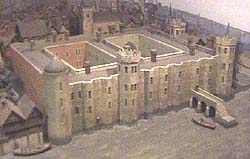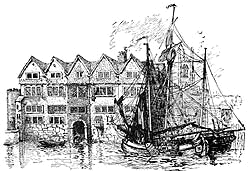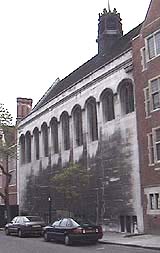|
Medieval London: A City of Palaces
By Walter Besant
Baynard's Castle stood first on
the river-bank close to the Fleet Tower and the
western extremity of the city wall. The great
house which afterwards bore this name was on the
bank, but a little more to the east. The name
survived in Baynard's Castle Ward and Wharf.
There was no house in the City more interesting
than this. Its history extends from the Norman
Conquest to the Great Fire - exactly six hundred
years; and during the whole of this long period
 it was a great palace. It was first built, as a
castle, by one Baynard, a follower of William the Conqueror.
It was forfeited in A.D. 1111, and
given to Robert FitzWalter, son of Richard, Earl
of Clare, in whose family the office of Castellan
and Standard-Bearer to the City of London became
hereditary. His descendant, Robert, in revenge
for private injuries, took part with the Barons
against King John, for which the King ordered
Baynard's Castle to be destroyed. FitzWalter,
however, becoming reconciled to the King, was
permitted to rebuild his house. In 1275, another
Robert FitzWalter gave the site to the Archbishop
of Canterbury for the foundation of the London
House of Dominican or Black Friars.At the
rebuilding of FitzWalter's 'castle' it was
somewhat shifted in position and it was probably
at this time that it lost its fortified
appearance. It was again destroyed, this time by
fire, in 1428. It was rebuilt by Humphrey, Duke
of Gloucester, on whose attainder it reverted to
the crown. Richard, Duke of York, had it next and
lived here with his following of four hundred
gentlemen and men-at-arms. It was in the hall of
Baynard's Castle that Edward IV assumed the title of King, and summoned
the bishops, peers and judges to meet him in
council. Edward gave the house to his mother, and
placed in it, for safety, his wife and children
before going out to fight the battle of Barnet.
Here Buckingham offered the crown to Richard III. it was a great palace. It was first built, as a
castle, by one Baynard, a follower of William the Conqueror.
It was forfeited in A.D. 1111, and
given to Robert FitzWalter, son of Richard, Earl
of Clare, in whose family the office of Castellan
and Standard-Bearer to the City of London became
hereditary. His descendant, Robert, in revenge
for private injuries, took part with the Barons
against King John, for which the King ordered
Baynard's Castle to be destroyed. FitzWalter,
however, becoming reconciled to the King, was
permitted to rebuild his house. In 1275, another
Robert FitzWalter gave the site to the Archbishop
of Canterbury for the foundation of the London
House of Dominican or Black Friars.At the
rebuilding of FitzWalter's 'castle' it was
somewhat shifted in position and it was probably
at this time that it lost its fortified
appearance. It was again destroyed, this time by
fire, in 1428. It was rebuilt by Humphrey, Duke
of Gloucester, on whose attainder it reverted to
the crown. Richard, Duke of York, had it next and
lived here with his following of four hundred
gentlemen and men-at-arms. It was in the hall of
Baynard's Castle that Edward IV assumed the title of King, and summoned
the bishops, peers and judges to meet him in
council. Edward gave the house to his mother, and
placed in it, for safety, his wife and children
before going out to fight the battle of Barnet.
Here Buckingham offered the crown to Richard III.
Alas, why
would you heap these cares on me? I am unfit for
state and majesty; I do beseech you, take it not
amiss, I cannot nor I will not, yield to you.
Henry VII lived in this palace, which he almost
entirely rebuilt. Prince Henry, after his marriage with Catherine of Aragon, was conducted in great state up the
river, from Baynard's Castle to Westminster, the
Mayor and Commonalty of the City following in
their barges. In the time of Edward VI, after his marriage with Catherine of
Aragon, was conducted in great state up the
river, from Baynard's Castle to Westminster, the
Mayor and Commonalty of the City following in
their barges. In the time of Edward VI, the Earl of Pembroke, whose wife was
sister to Queen Catherine Parr, held great state
in this house. Here he proclaimed Queen Mary monarch, as Lady Jane Grey had been only nine days before. When
Mary's first Parliament was held, he proceeded to
Baynard's Castle, followed by '2,000 horsemen in
velvet coats with their laces of gold and gold
chains, besides sixty gentlemen in blue coats
with his badge of the green dragon.' This
powerful noble lived to entertain Queen Elizabeth I at Baynard's Castle with a banquet,
followed by fireworks. The last appearance of the
place in history is when Charles II took supper there just before the Great
Fire of London swept over the building and
destroyed it.
 Another house by the river was that
called Coldharbour, Cold Harborough or Cold Inn.
This house stood just east of the present Cannon
Street Station. It was built, or possibly
purchased, by a rich City merchant, Sir John
Poultney, four times Mayor of London in 1334. At
the end of the fourteenth century it belonged,
however, to John Holland, Duke of Exeter, son of
Thomas Holland, Duke of Kent, and Joan
Plantagenet, the 'Fair Maid of Kent.' He was
half-brother to King Richard II , whom he here entertained. Richard III
gave it to the Heralds for their college. They
were turned out, however, by Henry VII, who gave
the house to his mother, Margaret, Countess of
Richmond. His son gave it to the Earl of
Shrewsbury and it was occasionally known as
Shrewsbury House. Coldharbour appears to have
fallen foul of the Great Fire, though a later
building of the same name, erected on the site,
was used as the Hall of the Watermen's Company
until 1778. Another house by the river was that
called Coldharbour, Cold Harborough or Cold Inn.
This house stood just east of the present Cannon
Street Station. It was built, or possibly
purchased, by a rich City merchant, Sir John
Poultney, four times Mayor of London in 1334. At
the end of the fourteenth century it belonged,
however, to John Holland, Duke of Exeter, son of
Thomas Holland, Duke of Kent, and Joan
Plantagenet, the 'Fair Maid of Kent.' He was
half-brother to King Richard II , whom he here entertained. Richard III
gave it to the Heralds for their college. They
were turned out, however, by Henry VII, who gave
the house to his mother, Margaret, Countess of
Richmond. His son gave it to the Earl of
Shrewsbury and it was occasionally known as
Shrewsbury House. Coldharbour appears to have
fallen foul of the Great Fire, though a later
building of the same name, erected on the site,
was used as the Hall of the Watermen's Company
until 1778.
Another royal residence was the
house called the Erber. This house also has a
long history. It is said to have been first built
by the Knight Pont de l'Arche, founder of the
Priory of St. Mary Overies. Edward III gave it to Geoffrey le Scrope. It
passed from him to John, Lord Neville, of Raby,
and so to his son Ralph Neville, Earl of
Westmorland, the staunch supporter of Henry IV . From him the Erber passed into the
hands of another branch of the Nevilles, the
Earls of Salisbury and Warwick. The Kingmaker
resided here, with a following so numerous that
six oxen were daily consumed for breakfast alone,
and any person who was allowed within the gates
could take away as much meat, sodden and roast,
as he could carry upon a long dagger. After his
death, George, Duke of Clarence - 'false,
fleeting, perjured Clarence' - obtained a
grant of the house, in right of his wife, Isabel,
daughter of Warwick the Kingmaker. Richard, Duke
of Gloucester, succeeded, and called it the
'King's Palace' during his brief reign. Edward,
son of the Duke of Clarence, then obtained it. In
the year 1584, the place, which seems to have
fallen into decay, was rebuilt by Sir Thomas
Pulsdon, Lord Mayor. Its last illustrious
occupant, according to Stow, was Sir Francis
Drake.
We are fortunate in having left
one house at least, or a fragment of one, out of
the many London palaces. The Fire of 1666 did not
reach Bishopsgate and so Crosby Hall was spared.
Though most of the old mansion has been pulled
down of the years, there yet remained the Hall to
be taken down and completely  re-erected in
Chelsea in 1909. The mansion formerly covered the
greater part of what is now called Crosby Square.
It was built by a simple citizen, a grocer and
Lord Mayor, Sir John Crosby, in the fifteenth
century. He was a man of great wealth and great
position: a merchant, diplomat, and ambassador.
He rode north to welcome Edward IV when he landed
at Ravenspur. He was sent by the King on missions
to the Duke of Burgundy and to the Duke of
Brittany. Shakespeare has Richard of Gloucester
living in this house as early as 1471, four years
before the death of Sir John Crosby, a thing not
likely. But he was living here at the death of
Edward IV, and here he held his levées before
his usurpation of the crown. In this hall sat the
last and worst of the Plantagenets thinking of
the two boys who stood between him and the crown.
Here he received the news of their murder. Here
he feasted with his friends. The place is charged
with the memory of Richard Plantagenet. Early in
the next century another Lord Mayor obtained it,
and lent it to the ambassador of the Emperor
Maximilian. It passed next into the hands of a
third citizen, also Lord Mayor, and was bought in
1516 by Sir Thomas More, who lived here for seven
years, and wrote in this house his Utopia
and his Life of Richard the Third. His friend
Antonio Bonvici, a merchant of Lucca, next lived
in the house. To him, More wrote his well-known
letter from the Tower. Successive owners or
occupants of this house include William Roper,
More's son-in-law, and William Rustill, his
nephew; Sir Thomas D'Arcy; William Bond, Alderman
and Sheriff, and merchant adventurer; Sir John
Spencer, ancestor of Lord Northampton; Mary,
Countess of Pembroke, and sister of Sir Philip
Sidney - the gentlest shepherdess that lived
that day - and Sir Stephen Langham. It was
partly destroyed by fire - not the Great Fire -
in the reign of Charles II. The Hall, which
escaped, was for seventy years a Presbyterian
meeting-house. It then became a packer's
warehouse. In the 1830s, it was partly restored,
and became a literary institution. In the late
19th century, it was a restaurant, gaudy with
colour and gilding. The Duc de Biron, ambassador
from France in the reign of Queen Elizabeth I was
lodged here with four hundred noblemen and
gentlemen in his train; and here also was lodged
the Duc de Sully. re-erected in
Chelsea in 1909. The mansion formerly covered the
greater part of what is now called Crosby Square.
It was built by a simple citizen, a grocer and
Lord Mayor, Sir John Crosby, in the fifteenth
century. He was a man of great wealth and great
position: a merchant, diplomat, and ambassador.
He rode north to welcome Edward IV when he landed
at Ravenspur. He was sent by the King on missions
to the Duke of Burgundy and to the Duke of
Brittany. Shakespeare has Richard of Gloucester
living in this house as early as 1471, four years
before the death of Sir John Crosby, a thing not
likely. But he was living here at the death of
Edward IV, and here he held his levées before
his usurpation of the crown. In this hall sat the
last and worst of the Plantagenets thinking of
the two boys who stood between him and the crown.
Here he received the news of their murder. Here
he feasted with his friends. The place is charged
with the memory of Richard Plantagenet. Early in
the next century another Lord Mayor obtained it,
and lent it to the ambassador of the Emperor
Maximilian. It passed next into the hands of a
third citizen, also Lord Mayor, and was bought in
1516 by Sir Thomas More, who lived here for seven
years, and wrote in this house his Utopia
and his Life of Richard the Third. His friend
Antonio Bonvici, a merchant of Lucca, next lived
in the house. To him, More wrote his well-known
letter from the Tower. Successive owners or
occupants of this house include William Roper,
More's son-in-law, and William Rustill, his
nephew; Sir Thomas D'Arcy; William Bond, Alderman
and Sheriff, and merchant adventurer; Sir John
Spencer, ancestor of Lord Northampton; Mary,
Countess of Pembroke, and sister of Sir Philip
Sidney - the gentlest shepherdess that lived
that day - and Sir Stephen Langham. It was
partly destroyed by fire - not the Great Fire -
in the reign of Charles II. The Hall, which
escaped, was for seventy years a Presbyterian
meeting-house. It then became a packer's
warehouse. In the 1830s, it was partly restored,
and became a literary institution. In the late
19th century, it was a restaurant, gaudy with
colour and gilding. The Duc de Biron, ambassador
from France in the reign of Queen Elizabeth I was
lodged here with four hundred noblemen and
gentlemen in his train; and here also was lodged
the Duc de Sully.
In a narrow street in the city,
called Tower Royal - Tour De La Reole,
built by merchants from Bordeaux - survives the
name of a house where King Stephen lived in the short intervals when he
was not fighting. King Richard II gave it to his
mother, and called it the Queen's Wardrobe. He
afterwards assigned it to Leon III, King of
Armenia, who had been dispossessed by the Turks.
Richard III gave it to John, Duke of Norfolk, who
lived here until his death at the Battle of
Bosworth Field. There is no description of the
house, which must have had a tower of some kind,
and there is no record of its demolition. Stow
only says that 'of late times it has been
neglected and turned into stabling for the king's
horses, and is now let out to divers men, and is
divided into tenements.'
The College of Arms in Queen
Victoria Street, already mentioned, stands on the
site of Derby House. Here the first Earl, who
married the mother of Henry VII, lived. Here the
Princess Elizabeth of York was the guest of the
Earl during the usurpation of Richard III. The
house was destroyed in the Fire and rebuilt in a
quadrangle, of which the front portion was
removed to make room for the new street.
Half a dozen great houses do
not make a city of palaces. That is true; but
there were many others. The FitzAlans, Earls of
Arundel, had their town house in Botolph Lane,
Billingsgate, down to the end of the sixteenth
century. The street is, and always has been,
narrow and, from its proximity to the
fish-market, is, and always has been, unsavoury.
The Earls of Northumberland had town houses
successively in Crutched Friars, Fenchurch Street
and Aldersgate Street. The Earls of Worcester
lived in Worcester Lane, on the river-bank. The
Duke of Buckingham on College Hill - observe how
the nobles, like the merchants, built their
houses in the most busy part of the town. The
Beaumonts and the Huntingdons lived beside Paul's
Wharf. The Lords of Berkeley had a house near
Blackfriars. Doctors' Commons was the town house
of the Blounts, Lords Mountjoy. Close to Paul's
Wharf stood the mansion once occupied by the
widow of Richard, Duke of York, mother of Edward
IV, Clarence and Richard III. Edward, the Black
Prince, lived on Fish Street Hill - the house was
afterward turned into an inn. The De La Poles had
a house in Lombard Street. The De Veres, Earls of
Oxford, lived first in St. Mary Axe and afterward
in Oxford Court, St. Swithin's Lane. Cromwell,
Earl of Essex, had a house in Throgmorton Street.
The Barons FitzWalter had a house where now
stands the Grocers' Hall, Poultry. In Aldersgate
Street were houses of the Earl of Westmorland,
the Earl of Northumberland, and the Earl of
Thanet, Lord Percie, and the Marquis of
Dorchester. Suffolk Lane marks the site of the
'Manor of the Rose,' belonging successively to
the Suffolks and the Buckinghams. Lovell's Court,
Paternoster Row, marks the site of the LoveIl's
mansion. Between Amen Corner and Ludgate Street
stood Abergavenny House where lived, in the reign
of Edward II, the Earl of Richmond and Duke of
Brittany, grandson of Henry III. Afterward it became the house of John
Hastings, Earl of Pembroke, who married Lady
Margaret, daughter of Edward III. It passed to
the Nevilles, Earls of Abergavenny, and from them
to the Stationers' Company. Warwick Lane runs
over Warwick House. The Sidneys, Earls of
Leicester, lived in the Old Bailey. The
Staffords, Dukes of Buckingham, lived in Milk
Street.
Such a list, numbering no fewer
than thirty-five palaces, is by no means
exhaustive, and does not include the town houses
of the Bishops and great Abbots, nor the halls of
the companies, many of them very noble, nor the
houses used for the business of the city, such as
Blackwell Hall and Guildhall. It is, however,
sufficient to prove that London was indeed a City
of Palaces.
Edited by David Nash Ford, from
Walter Besant's London (1892).
|
© 2016 offtolondon.com All rights reserved.
Contact Us |
|
|
| |